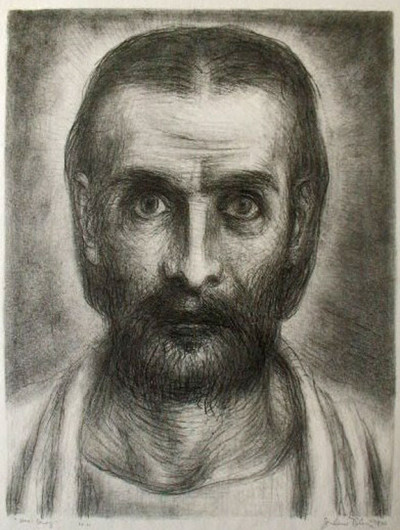
Julius Bloch
Head Study
Lithograph
As a keen collector of contemporary sacred art, I find there are so many works where the religious subject matter is readily recognized or identified by title that I tend to shy away from art of less certain meaning. Once in a while a piece comes along to confound my well-defined categories like Graphic Artist Julius Bloch’s 1940 lithograph, Head Study. When I first saw Bloch’s icon-like, full-faced portrait of this bearded man with riveting eyes, dressed in flowing white clothes, and encircled by an aura of light, I was absolutely convinced this was an image of Christ. I hoped a bit of research would support my hunch. It didn’t. At least, not in plain text. A German-Jewish immigrant to the United States, Bloch found the subjects for his art among the working class poor, African-Americans, dispossessed farmers, and other victims of the Great Depression. Bloch did become fascinated with Byzantine mosaics later in his life but not at the time this image was made. I discovered another lithographic portrait, titled The Refugee, using the very same model, made at the very same time. In the second print, the figure’s head was turned slightly to the right. Once the electric connection with those penetrating eyes was broken, I started to have doubts about the first image. The haircut now seemed to be thoroughly modern. What I had taken for biblical garb might well have been a white towel draped over a T-shirt. Had I gotten it wrong? Thinking it over, I came to see I wasn’t so far off in recognizing Christ in the haunted features of the refugee model, who might have been a Jew, fleeing Nazi persecution in Europe--or in any of Bloch’s studies of the poor and the displaced. Christ was, in the words of the Prophet Isaiah, “a man of sorrow and acquainted with grief,” and his face most surely fits the contours of every human face that has ever been creased by anguish and etched by pain.
